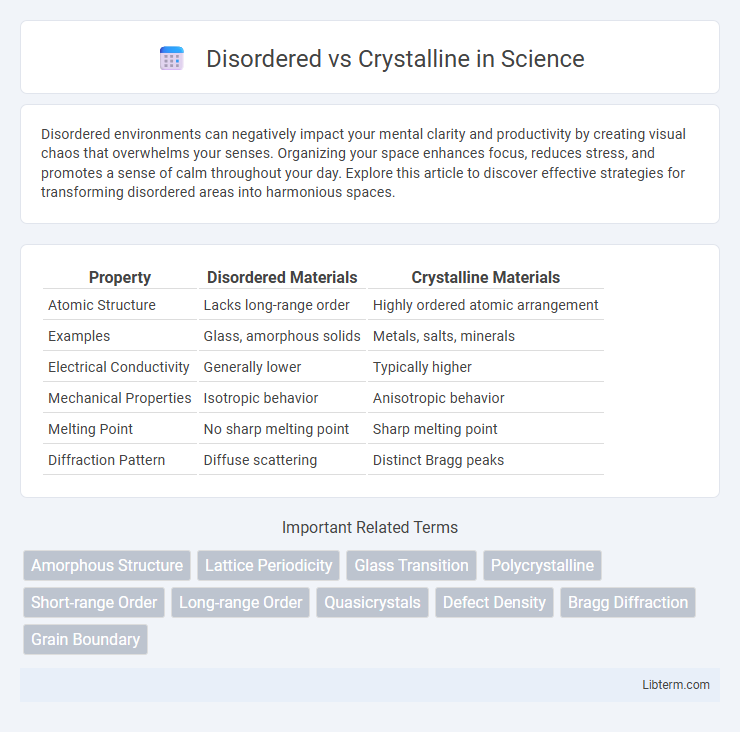Disordered environments can negatively impact your mental clarity and productivity by creating visual chaos that overwhelms your senses. Organizing your space enhances focus, reduces stress, and promotes a sense of calm throughout your day. Explore this article to discover effective strategies for transforming disordered areas into harmonious spaces.
Table of Comparison
| Property | Disordered Materials | Crystalline Materials |
|---|---|---|
| Atomic Structure | Lacks long-range order | Highly ordered atomic arrangement |
| Examples | Glass, amorphous solids | Metals, salts, minerals |
| Electrical Conductivity | Generally lower | Typically higher |
| Mechanical Properties | Isotropic behavior | Anisotropic behavior |
| Melting Point | No sharp melting point | Sharp melting point |
| Diffraction Pattern | Diffuse scattering | Distinct Bragg peaks |
Understanding Disordered and Crystalline Structures
Disordered structures lack a definitive geometric arrangement, resulting in irregular atomic or molecular placements that affect material properties such as conductivity and strength. Crystalline structures exhibit long-range order with atoms arranged in repeating patterns, producing distinct physical characteristics like defined melting points and anisotropic behavior. Understanding these structural differences is crucial for tailoring materials in fields such as electronics, metallurgy, and pharmaceuticals.
Atomic Arrangements: Random vs Ordered
Disordered materials exhibit atomic arrangements characterized by randomness and lack of periodicity, resulting in isotropic properties and diffuse diffraction patterns. In contrast, crystalline structures display highly ordered, repeating atomic patterns forming a lattice that imparts anisotropic properties and sharp X-ray diffraction peaks. This fundamental difference in atomic order influences mechanical, thermal, and electrical behavior across materials like glasses, polymers, metals, and ceramics.
Key Differences in Physical Properties
Disordered materials exhibit irregular atomic arrangements, resulting in lower density, reduced thermal conductivity, and increased electrical resistivity compared to crystalline solids with their highly ordered lattice structures. Crystalline materials show sharp melting points and anisotropic mechanical properties, while disordered materials typically have a broad melting range and isotropic behavior. Structural defects in disordered materials create localized electronic states, influencing optical transparency and mechanical strength differently than the uniform properties observed in crystals.
Examples of Disordered and Crystalline Materials
Disordered materials include amorphous solids like glass and polymers, where atoms lack long-range periodic order, resulting in random atomic arrangements. Crystalline materials, such as metals like copper and aluminum, and minerals like quartz and diamond, exhibit highly ordered atomic structures with repeating lattice patterns. These distinct atomic arrangements influence their physical properties, including mechanical strength, optical behavior, and thermal conductivity.
Formation Processes: How Structures Emerge
Disordered structures form through rapid cooling or quenching, which prevents atoms from arranging into a regular lattice, resulting in amorphous materials like glasses and polymers. Crystalline structures emerge via slow cooling or controlled solidification, allowing atoms to align into highly ordered, repeating lattice patterns characteristic of metals, minerals, and salts. Nucleation and growth mechanisms dominate crystal formation, whereas kinetic constraints and energy barriers lead to the development of disordered phases.
Impact on Electrical and Thermal Conductivity
Disordered materials exhibit lower electrical and thermal conductivity due to increased scattering of electrons and phonons at defects and grain boundaries. In contrast, crystalline structures have well-ordered atomic arrangements that facilitate efficient charge carrier movement and heat transfer through lattice vibrations. This fundamental difference significantly impacts the performance of semiconductors, thermoelectric devices, and conductive polymers in electronic and thermal management applications.
Applications in Modern Technology
Disordered materials, such as amorphous silicon, are widely used in thin-film transistors and photovoltaic cells due to their flexibility and cost-effective manufacturing processes. Crystalline materials, like monocrystalline silicon, dominate semiconductor industries for their superior electrical conductivity and electron mobility, which are essential in microprocessors and high-efficiency solar panels. Emerging technologies exploit the unique properties of both structures to optimize performance in flexible electronics, optoelectronics, and energy storage systems.
Structural Stability and Durability
Disordered materials exhibit lower structural stability due to their irregular atomic arrangements, resulting in increased susceptibility to deformation and failure under stress. Crystalline structures, characterized by a highly ordered atomic lattice, provide enhanced durability through uniform bonding and resistance to defects. The predictable geometry in crystalline materials contributes to their superior mechanical strength and long-term performance in various applications.
Analytical Techniques for Identification
X-ray diffraction (XRD) is a primary analytical technique used to differentiate disordered from crystalline materials by identifying unique diffraction patterns indicative of atomic order. Raman spectroscopy provides complementary insights by detecting vibrational modes that vary between well-ordered crystalline structures and amorphous or disordered phases. Differential scanning calorimetry (DSC) further assists in characterization by measuring thermal transitions, highlighting distinct melting points in crystalline substances versus broader thermal events in disordered materials.
Future Trends in Material Science
Future trends in material science emphasize the design of hybrid materials that combine disordered and crystalline structures to optimize mechanical strength and electronic properties. Advanced computational models and machine learning algorithms are increasingly used to predict the behavior of these complex materials under various conditions. Innovations in synthesis techniques aim to control the degree of disorder at the nanoscale, enabling tailored functionalities for applications in energy storage, flexible electronics, and quantum computing.
Disordered Infographic

 libterm.com
libterm.com